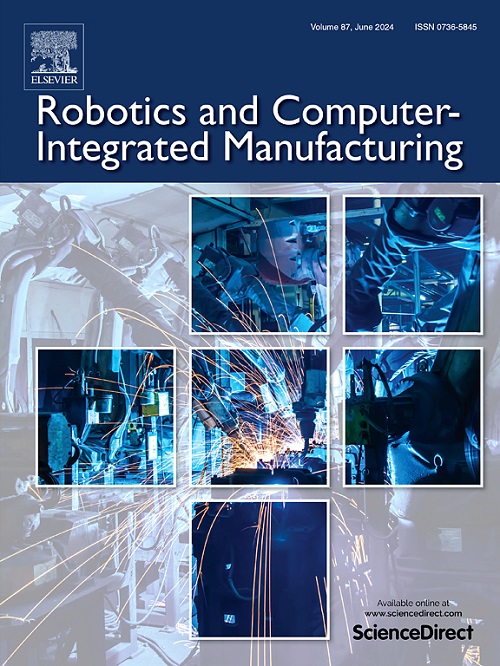Semi-active damping for industrial robots
IF 11.4
1区 计算机科学
Q1 COMPUTER SCIENCE, INTERDISCIPLINARY APPLICATIONS
引用次数: 0
Abstract
The dynamic accuracy of industrial robots is significantly influenced by the elastic drive trains of the axes. Their behavior is composed of the coupled dynamics of drive control and gear mechanics. As an undesirable consequence, increasing elasticity leads to growing tracking errors. One approach to reduce tracking errors is semi-active damping. The functional principle is based on damping the gear mechanics by selective braking of an additional actuator. From a drive control perspective, this results in a more favorable system behavior, which, in turn, allows the selection of more performant control parameter values. This leads to better tracking and disturbance behavior. The aim of this paper is to transfer the semi-active damping with a low-cost additional actuator to cascade-controlled industrial robots. For this purpose, a novel semi-active control law is proposed for actuator control. A damping actuator for the first robot axis is designed, design rules are derived, and an integration concept is proposed. Finally, a H synthesis methodology for simultaneous parameterization of the drive and actuator control is introduced. An experimental validation proves the effectiveness of the solution at axis level resulting in an average 17.3 % reduction in tracking errors, and in a milling experiment, reducing the average Euclidean tracking error by 42.7 %.

用于工业机器人的半主动阻尼
轴系的弹性传动对工业机器人的动态精度影响很大。它们的行为是由传动控制动力学和齿轮力学耦合动力学组成的。作为一个不希望的结果,增加弹性会导致跟踪错误的增加。一种减小跟踪误差的方法是半主动阻尼。其功能原理是基于通过选择性制动附加执行器来阻尼齿轮力学。从驱动控制的角度来看,这导致了更有利的系统行为,这反过来又允许选择更高性能的控制参数值。这导致更好的跟踪和干扰行为。本文的目的是通过低成本的附加驱动器将半主动阻尼传递到级联控制的工业机器人中。为此,提出了一种新的半主动控制律用于执行器控制。设计了机器人第一轴的阻尼作动器,推导了设计规则,并提出了集成的概念。最后,介绍了驱动和执行器控制同时参数化的H∞综合方法。实验验证了该方案在轴水平的有效性,平均降低了17.3%的跟踪误差,在铣削实验中,平均降低了42.7%的欧氏跟踪误差。
本文章由计算机程序翻译,如有差异,请以英文原文为准。
求助全文
约1分钟内获得全文
求助全文
来源期刊
CiteScore
24.10
自引率
13.50%
发文量
160
审稿时长
50 days
期刊介绍:
The journal, Robotics and Computer-Integrated Manufacturing, focuses on sharing research applications that contribute to the development of new or enhanced robotics, manufacturing technologies, and innovative manufacturing strategies that are relevant to industry. Papers that combine theory and experimental validation are preferred, while review papers on current robotics and manufacturing issues are also considered. However, papers on traditional machining processes, modeling and simulation, supply chain management, and resource optimization are generally not within the scope of the journal, as there are more appropriate journals for these topics. Similarly, papers that are overly theoretical or mathematical will be directed to other suitable journals. The journal welcomes original papers in areas such as industrial robotics, human-robot collaboration in manufacturing, cloud-based manufacturing, cyber-physical production systems, big data analytics in manufacturing, smart mechatronics, machine learning, adaptive and sustainable manufacturing, and other fields involving unique manufacturing technologies.

 求助内容:
求助内容: 应助结果提醒方式:
应助结果提醒方式:


